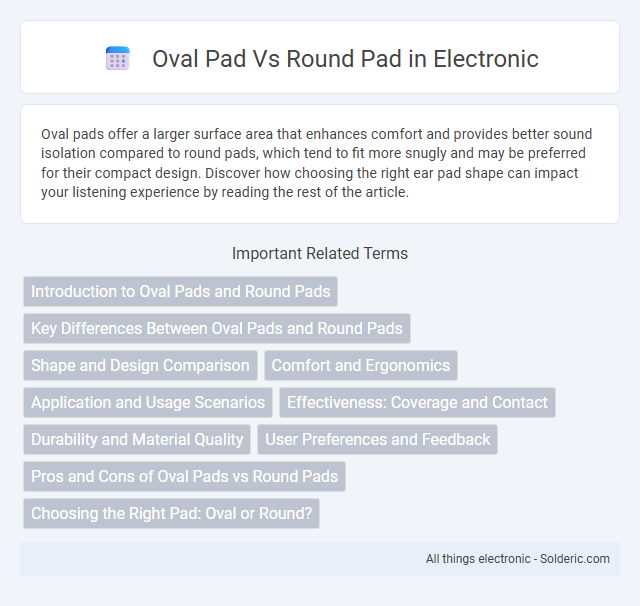Oval pads offer a larger surface area that enhances comfort and provides better sound isolation compared to round pads, which tend to fit more snugly and may be preferred for their compact design. Discover how choosing the right ear pad shape can impact your listening experience by reading the rest of the article.
Comparison Table
| Feature | Oval Pad | Round Pad |
|---|---|---|
| Shape | Elongated oval | Circular |
| Coverage Area | Wider, covers larger surface | Smaller, focused area |
| Best For | Edge-to-edge polishing, smooth contours | Spot polishing, small areas |
| Usage | Auto detailing, finishing tasks | Detail work, tight spots |
| Durability | Provides even pressure, longer wear | May wear faster due to focused pressure |
| Compatibility | Fits specific oval backing plates | Compatible with standard round backing plates |
Introduction to Oval Pads and Round Pads
Oval pads and round pads are common types of surface mount technology (SMT) pads used in printed circuit board (PCB) design, each offering distinct advantages depending on component shape and soldering requirements. Oval pads provide a larger surface area for better solder wetting and mechanical strength, making them suitable for components subjected to thermal expansion or stress. Round pads are simpler in shape and facilitate automated solder paste printing, often chosen for standard components with minimal mechanical demands.
Key Differences Between Oval Pads and Round Pads
Oval pads feature an elongated shape that offers greater surface coverage and better conforms to the contours of various instruments or devices, enhancing stability and comfort compared to round pads. Round pads have a symmetrical, circular design that provides uniform pressure distribution, making them suitable for applications requiring consistent contact and easy alignment. Material composition and thickness may vary between oval and round pads, influencing their durability, cushioning, and suitability for specific uses such as musical instruments, medical devices, or industrial equipment.
Shape and Design Comparison
Oval pads provide a larger surface area that conforms better to the contours of the face, enhancing comfort and improving sound isolation during use. Round pads offer a more uniform seal but may create pressure points, making them less comfortable for prolonged wear. The shape and design of oval pads tend to accommodate diverse ear shapes more ergonomically, contributing to an improved listening experience.
Comfort and Ergonomics
Oval pads provide superior comfort by conforming more naturally to the contours of the ear, reducing pressure points and enhancing ergonomic fit for extended wear. The elongated shape distributes weight evenly, minimizing discomfort and preventing ear fatigue compared to round pads that may create localized pressure. Ergonomically designed oval pads improve seal and noise isolation, contributing to a more immersive and comfortable listening experience.
Application and Usage Scenarios
Oval pads provide a larger surface area, making them ideal for applications that require extensive coverage and smoother, more even finishes, such as polishing large automotive panels or furniture surfaces. Round pads excel in detailed work and precision tasks, commonly used for spot repairs, contouring, and smaller surfaces where maneuverability and control are crucial. Your choice between oval and round pads should align with the specific application demands--oval pads suit broad, flat areas while round pads are better for tight, intricate spots.
Effectiveness: Coverage and Contact
Oval pads provide greater coverage and maintain more consistent contact with the skin compared to round pads, enhancing overall effectiveness in treatments such as electrode placements or skincare applications. Their elongated shape conforms better to body contours, reducing the risk of edge lifting and ensuring stable electrical conductivity or product absorption. In contrast, round pads may have limited coverage area and uneven skin contact, potentially compromising the uniformity and efficacy of the intended therapy or treatment.
Durability and Material Quality
Oval pads often offer enhanced durability due to their larger surface area distributing pressure more evenly, which reduces wear and tear compared to round pads. High-quality materials like memory foam or leather on oval pads contribute to longer lifespan and better resistance to deformation. Choosing an oval pad can improve your experience by providing both durability and superior material quality, ensuring extended usage.
User Preferences and Feedback
User preferences for oval pads often highlight superior comfort and better ear coverage compared to round pads, enhancing noise isolation and audio experience. Feedback indicates that oval pads conform more naturally to the ear's shape, reducing pressure points during extended use. Round pads remain favored for their portability and compatibility with a wider range of headphone models, appealing to users prioritizing convenience.
Pros and Cons of Oval Pads vs Round Pads
Oval pads offer a larger surface area that enhances comfort and distributes pressure more evenly, reducing ear fatigue during extended use. Round pads typically provide a tighter seal that can improve passive noise isolation but may cause localized pressure points, leading to discomfort. Choosing between oval and round pads depends on prioritizing either broad comfort and fit (oval) or focused sound isolation and portability (round).
Choosing the Right Pad: Oval or Round?
Choosing between oval and round pads depends on the intended use and surface area coverage. Oval pads provide greater surface contact, making them ideal for polishing and buffing larger areas efficiently, while round pads offer precision and maneuverability in tight or curved spaces. Selecting the right pad enhances effectiveness and ensures optimal results for automotive detailing, woodworking, or cleaning tasks.
oval pad vs round pad Infographic

 solderic.com
solderic.com